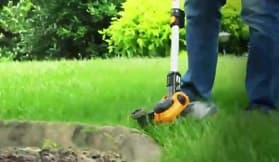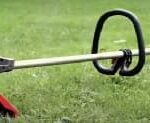As an Amazon Associate, this site earns commissions from qualifying purchases. For more information click here.
This has to be one of the longest running debates in lawn care. Should you take off the trimmer guard? There are people who swear it leads to better results, but there are also others who will say that is going to cause more harm than good. So which one is it?
Some people remove the trimmer guard because they find it easier to trim and get more string. However, the guard protects the user from rocks and other debris. So for safety reasons you should not take the trimmer guard off.
Advantages of Removing the Trimmer Guard
The idea of removing the guard seems foolish, as it is required for the best trimmer safety practices. But ask lawn care buffs and they will tell you a lot of them – especially those who have been doing this for years – take the guard off.
Get a Longer Line
This is one of (if not the) biggest argument in favor of removing the guard. Yes the guard provides protection, but it also limits the amount of string you can use.
The guard limits the string to the appropriate length to prevent engine overload. But it can be frustrating if you are working on a large area.
If the string is too short it will require multiple passes to finish a section. Trimming overgrown land is definitely going to benefit from a longer line. If you need a more powerful trimmer, we recommend the Husqvarna 128LD because it allows you to work through a lot of weeds without needing to get rid of the guard.
Unfortunately you can only get more string by removing the guard. It does have drawbacks which we will look at later, but some are willing to overlook that for better performance.
Greater Trimming Control
String trimmers have improved over the years, and you exercise good control over it. But the guard does limit the string’s visibility when you edge.
This only becomes an issue if you use a string trimmer as an edger. One way to do this is to use the TrimmerPlus TPE720 Dual Edger Attachment for weed eaters. If your weed eater is compatible with TrimmerPlus, this attachment will work.
Some people have a hard time seeing the edge because of the guard. If you remove it you will see the edge clearly. You have greater control over the process. For some, taking away the guard leads to better edges and quicker cuts.
This short video gives you a nice overview on the pros and cons of using or not using a string trimmer guard.
Disadvantages of Removing the Trimmer Guard
Now that you have gone over the benefits of removing the guard, let us look at the reasons to keep it on. Most of these center on operator safety and also to protect the machine.
Operator Safety and Security
When you use a string trimmer, rocks, sticks and debris fly all around. The guard also slows the momentum of debris as they come up.
If you decide to take the guard off, wear thick pants to protect yourself. Without it you could get hurt by sharp rocks and other debris.
There are a couple of other reasons why you should never remove the trimmer guard. First, some insurance companies will not cover claims if you dismantled the guard and got injured.
Second, your homeowners’ association almost certainly doesn’t allow it. That should not be a problem if you are alone while trimming, but what if a bystander gets hurt by flying rocks? And they find out you were cutting without a guard? That could be real trouble.
Manage the Trimmer Line
One of the reasons why people take out the guard is to get more line. The guard does this on purpose to prevent engine overload. If you use too much line it could lead to high temperature, slow RPM and reduced trimming efficiency.
If you look at the guard you will see a blade. When you hit the trimmer head on the surface, extraneous lines are removed.
What the guard does is balance the line length, long enough to cut but not too long it wears out the engine. This is where some users have problems. The safety mechanism is too restrictive and limits the useful line required.
If you remove the guard you do get access to a longer line. But it has drawbacks:
- No safety feature
- The trimmer can no longer keep the string consistent
- Minus the guard, the vibration increases when you run the machine
- Longer line increases engine load and temperature

Potential Long-Term Damage
Aside from personal safety, the guard also prevents the engine from overheating. Keeping the guard on is one of the keys to prolonging the life of a string trimmer.
Even those who prefer no guards acknowledge this fact. The longer the line the heavier the engine toll. The bearings, clutch, crankshaft, spark plug, filters etc. all get worn out faster.
Voided warranty. Taking out the guard is going to void the warranty. So if the machine breaks down you have to pay for it. And as we have pointed out, using the trimmer without the guard will wear out its parts faster.
While you may get short term benefits (faster, straighter cuts), you could end up paying more literally if the machine breaks down.
Optimize Performance
The guard ensures the string trimmer runs in optimum condition. If you are having problems – for example, the weed eater dies when you give it gas , you should set up the tool the way it is supposed to be. And that includes keeping this safety feature on.
The bottom line is it is your call. If you are an expert and feel comfortable using a string trimmer without a guard, remove it. As many have said it can lead to better trims. But if you are a beginner and concerned for safety, keep the guard on.
Related Questions
is it better to leave the trimmer guard or not?
For safety reasons you should not remove the guard. The risk of being cut by sharp rocks is real and without protection, can be dangerous. If you cannot get the results you want, the problem is not the guard but the trimmer.
Is there a way to get a longer line without taking the guard off?
No. The guard controls the amount of string you get out of the feed. This is necessary to prevent the engine temperature from rising. If you pull out too much line, the engine is going to overheat.
What are the biggest benefits of keeping the trimmer guard on?
The line is always balanced. String out is limited which conserves engine life and the warranty will not be voided. If you are looking for line consistency it makes sense to keep the guard. The biggest benefit of course is operator safety.
What are the benefits of removing the trimmer guard?
You get to use a longer string. Short strings reduce engine wear, but it can be limiting. Take the guard off and you can use as much string as you want.
Aside from a longer string, operators say you have greater control over the string, movement is smoother and you get work done faster. Mileage may vary among trimmer users, but it can improve string visibility.
Does removing the guard damage the clutch?
Taking off the guard will not directly affect the clutch or any engine part. Without the guard though, there is nothing to prevent the engine temperature from rising.
Operators take the guard out so they can use more string. But this can overload the engine. That is why the guard restricts the length of string you can use, to protect the engine. Take out the guard and the engine -including the clutch – is more vulnerable to damage.
Will you really be in danger if you take the guard off?
It depends on what kind of trimming you do and where. If you cleaned the area beforehand, wear thick pants and safety goggles, you are probably safe.
But if you wear shorts or have no shin protection, you could get scratches from flying debris. If you trim anywhere with lots of small rocks or sand, you definitely will want to keep that guard in place.

I love the outdoors and all the tools for maintaining gardens, yards and lawns. The only thing I am more passionate about is sharing what I know about garden and outdoor equipment.


